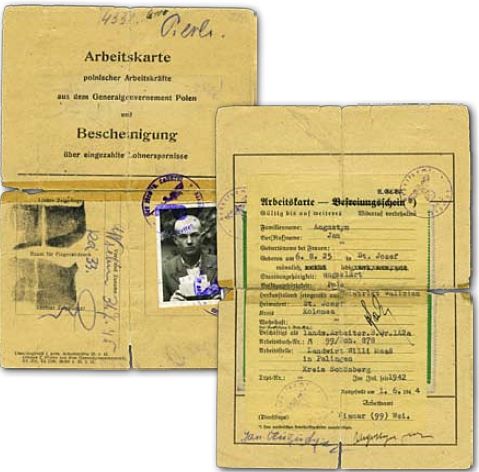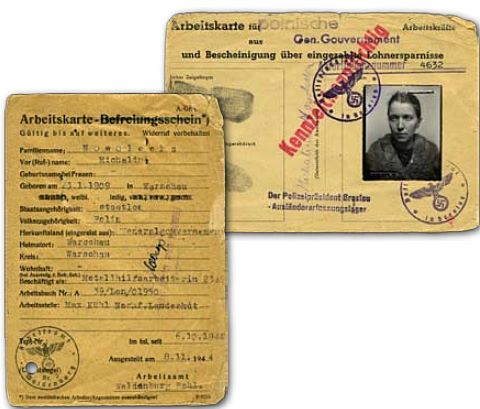“work card” was a document with a double function: it confirmed the employment of a foreign worker, and served also as passport or identity card. It was necessary to have your work card as of the 8 March 1940. When receiving this card, a collaboration of two offices was needed: the Arbeitsamt and the local police authority (the Department of Foreigners). A special permit was required to a foreign worker’s employment in Germany. In order to employ a foreigner, an employer had to apply for the permission at the local police authority. The foreign employee should also apply to the Local Police Authority, but in practice the employers applied for this permission. In 1942, due to the increase of foreign workers the Office of Labor was forced to simplify the procedure. The employer had to make a general request to the Office of Labor for the allocation of workers. Later they canceled this procedure, that you had to apply to the local police authority. It became the task of the Arbeitsamt, which, after allocation of the worker to a specific job sent a permission form which had to be filled. This ended the formalities of registration, combined with a photo of fingerprints, forwarded from the employee. The data obtained by the police while issuing work cards remained in the Police Office. Copies of this data were stored in the central records of the Reich Security Main Office which held the data on the forcibly recruited Poles and Ostarbeiter. This Main Office functioned until the end of 1943 or early 1944, when it was destroyed by Allied bombing raids. There were information about these raids in a circular (the circular informed Reichsfűhrer SS on the 5th of February 1944 about these events). The worker was required to carry the Arbeitskarte with him. The Arbeitskarte was valid for a specific employment, which eased the process of catching the fugitives. Since the Arbeitskarte was issued for a limited period of time, the employer should take care about prolonging it.

In consisted in a two-sided card slip. On one side it contained a photograph, a fingerprint and the signature of the worker. This page was prepared by the police. In February 1944 provision was made for the necessity of inserting on this page a stamp that read: kennzeichenpflichtig – required to wear the identity emblem, namely the “P” in the case of the Poles or the “O” for eastern workers, so as to help the police authority of GG to distinct from the Belorussians and Ukrainians, who were exempted from the compulsory wearing of signs. There was a sheet which contained personal data, and information about the employment of that forced laborer. If the validation date had expired but the worker was still working, the new sheet could be glued over the old one. In contrast to Arbeitsbuch, which was filled out by hand, this document was filled by typing. Similar to Arbeitsbuch, it contained information about action and interference the holder might have had with Allied authorities, and/or postwar Polish government, institution where he had received social support.

This card was also sometimes combined with a certificate of the deposits of their salary savings (Bescheinigung über eingezahlte Lohnerparnisse). However, in practice, this was seldom written down. Deducting various sums of money from the earnings of workers and their deposit from the employer was a way of bonding the worker with the employer. The plan of the German administration was to prevent escapes from the working places but in practice it turned out to be quite ineffective.